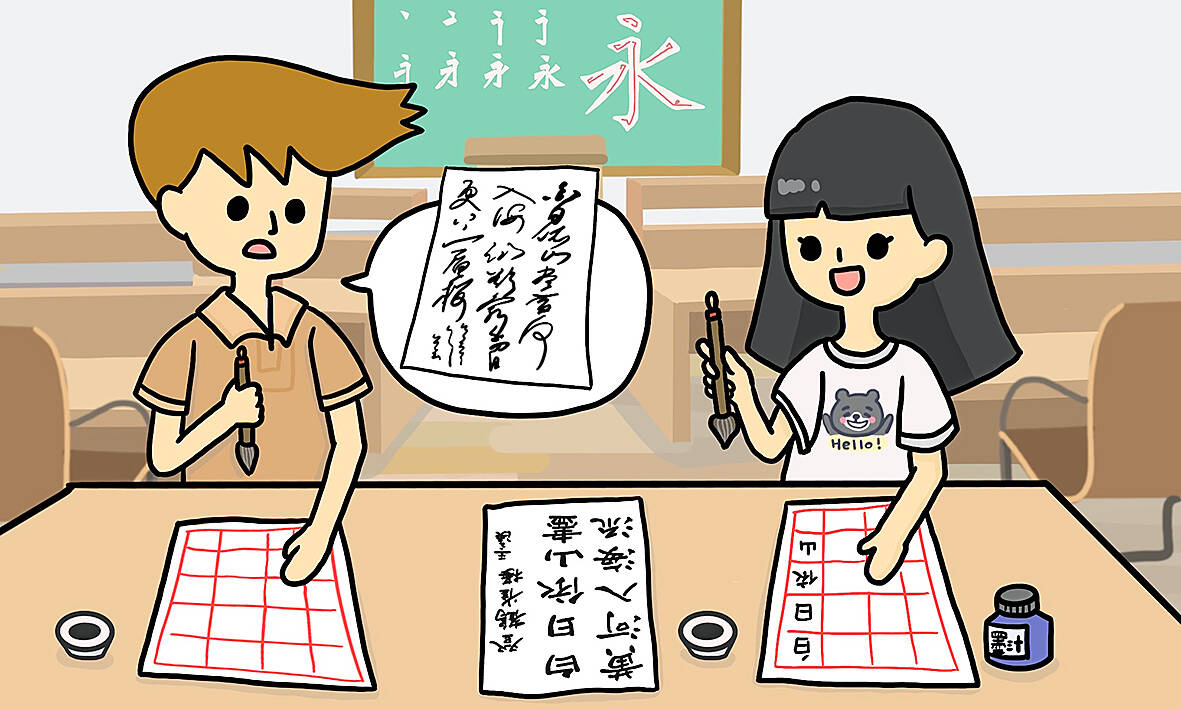對話 Dialogue
小實:馬克,拿毛筆和拿原子筆的方式不一樣哦,你看!
Xiǎoshí: Mǎkè, ná máobǐ hàn ná yuánzǐbǐ de fāngshì bù yíyàng ó, nǐ kàn!

馬克:食指、中指……這樣拿筆,好難寫字。
Mǎkè: Shízhǐ, zhōngzhǐ... zhèyàng ná bǐ, hǎo nán xiězì.
小實:所以才要練習啊!你可以先看這個字帖。
Xiǎoshí: Suǒyǐ cái yào liànxí a! Nǐ kěyǐ xiān kàn zhège zìtiě.
馬克:「字帖」?你要我照著這個字來寫嗎?
Mǎkè: “Zìtiě”? Nǐ yào wǒ zhàozhe zhège zì lái xiě ma?
小實:對,這些都是有名的書法家的字帖。
Xiǎoshí: Duì, zhèxiē dōu shì yǒumíng de shūfǎjiā de zìtiě.
馬克:小實,我想學那種像蛇一樣的書法風格,很漂亮吔。
Mǎkè: Xiǎoshí, wǒ xiǎng xué nàzhǒng xiàng shé yíyàng de shūfǎ fēnggé, hěn piàoliàng ye.
小實:哦,那是「草書」,不過我們應該從楷書開始學習。
Xiǎoshí: Ó, nà shì “cǎoshū”, búguò wǒmen yīnggāi cóng kǎishū kāishǐ xuéxí.
馬克:好吧!我先練習拿毛筆和寫楷書。
Mǎkè: Hǎo ba! Wǒ xiān liànxí ná máobǐ hàn xiě kǎishū.
翻譯 Translation
Xiaoshi: Mark, see? The way you hold a Chinese brush and a ballpoint pen are different.
Mark: Forefinger, middle finger …holding the pen like this makes it difficult to write.
Xiaoshi: That’s why we need to practice! You can follow these “zitie” (copybook) first.
Mark: “Zitie?” Do you want me to write the characters according to this copybook?
Xiaoshi: Yes, these are copybooks by famous calligraphers.
Mark: Xiaoshi, I want to learn that snakelike calligraphy style, it’s beautiful.
Xiaoshi: Oh, that’s “cursive script,” but we should start learning from regular script.
Mark: OK! I will practice holding the brush and writing regular script first.
單字片語 Vocabulary
1. 毛筆 máobǐ Chinese calligraphy brush
2. 原子筆 yuánzǐbǐ ballpoint pen
3. 食指 shízhǐ forefinger, index finger
4. 字帖 zìtiě copybook
5. 照(著)zhào (zhe) according to; accordingly
6. 書法家 shūfǎjiā calligrapher
7. 風格 fēnggé style
8. 草書 cǎoshū cursive script
9. 楷書 kǎishū regular script
教材音檔 Audio Files
教材影片 Video Files:
https://www.instagram.com/celc.nou_tw/guide/_/17999106352646292/
實踐大學華語中心提供
By Shih Chien University Chinese Language Center: https://chineseusc.com/

The Dutch introduced the Indian mango (Mangifera indica) to Taiwan in the 17th century. It is a green-skinned mango with thick fibers that get stuck in the teeth, but it boasts a rich aroma and a unique taste. In 1954, Taiwan’s Council of Agriculture introduced several mango cultivars from Florida, USA, including the Irwin, Haden, and Keitt varieties. After seven years of testing and domestication, the Irwin variety was chosen for promotion. Years later, the sample saplings started to bear fruit. These mangoes were large, with thin, vibrant red peels and golden pulp. The Irwin mangoes were mouth-wateringly sweet and

As the priest Antonius Hambroek stood in the dim chamber of Fort Zeelandia, his eldest daughter clung to him, her voice trembling. “Father, don’t go. They’ll kill you, and what will become of Mother and my sisters?” Outside, the sounds of Koxinga’s relentless canon siege boomed through the fortress. The defenders were on the brink of collapse. Starvation gnawed at their resolve, and the air carried the acrid stench of spent gunpowder and rotting flesh. Dutch reinforcements from Batavia had failed to arrive, leaving the garrison isolated and hopeless. Hambroek’s face was calm, though sorrow weighed heavily on his

對話 Dialogue 清清:今天中午我要多吃一點,不然晚上可能會吃不飽。 Qīngqing: Jīntiān zhōngwǔ wǒ yào duō chī yìdiǎn, bùrán wǎnshàng kěnéng huì chībùbǎo. 華華:怎麼了?為什麼會吃不飽? Huáhua: Zěnmele? Wèishénme huì chībùbǎo? 清清:今天大年初七,是「人日節」,傳統上結了婚的女兒要回家給父母送長壽麵,而且最好是素的,我姐姐會回來,只吃素麵,我應該很快就餓了。 Qīngqing: Jīntiān Dànián chūqī, shì “Rénrì jié,” chuántǒng shàng jiéle hūn de nǚ’ér yào huíjiā gěi fùmǔ sòng chángshòumiàn, érqiě zuìhǎo shì sù de, wǒ jiějie huì huílái, zhǐ chī sùmiàn, wǒ yīnggāi hěn kuài jiù èle. 華華:我還是第一次聽說有「人日節」呢!這是怎麼來的啊? Huáhua: Wǒ háishì dì yī cì tīngshuō yǒu “Rénrì jié” ne! Zhè shì zěnme lái de a? 清清:老一輩的人說,女媧是在第七天造出了「人」,所以今天可說是我們每個人的「生日」呢!生日快樂! Qīngqing: Lǎoyíbèi de rén shuō, Nǚwā shì zài dì qī tiān zào chūle “rén,” suǒyǐ jīntiān kěshuōshì wǒmen měi ge rén de “shēngrì” ne! Shēngrì kuàilè! 華華:你也是啊!欸?那前六天女媧都做了什麼呢? Huáhua: Nǐ yěshì a! Éi? Nà

As we bundle up in thick coats to stay warm during the winter, there is a population that has already adapted to extremely low temperatures. These people live in the remote city of Yakutsk, the coldest city on Earth. Yakutsk is situated in the heart of Siberia, which is the capital of the Sakha Republic in Russia. This historic mining city began to flourish in the 19th century following the discovery of gold deposits. Given its construction on permafrost, the average temperature in the city remains below 0°C for over half the year, with winter temperatures dropping to an astonishing -50°C.